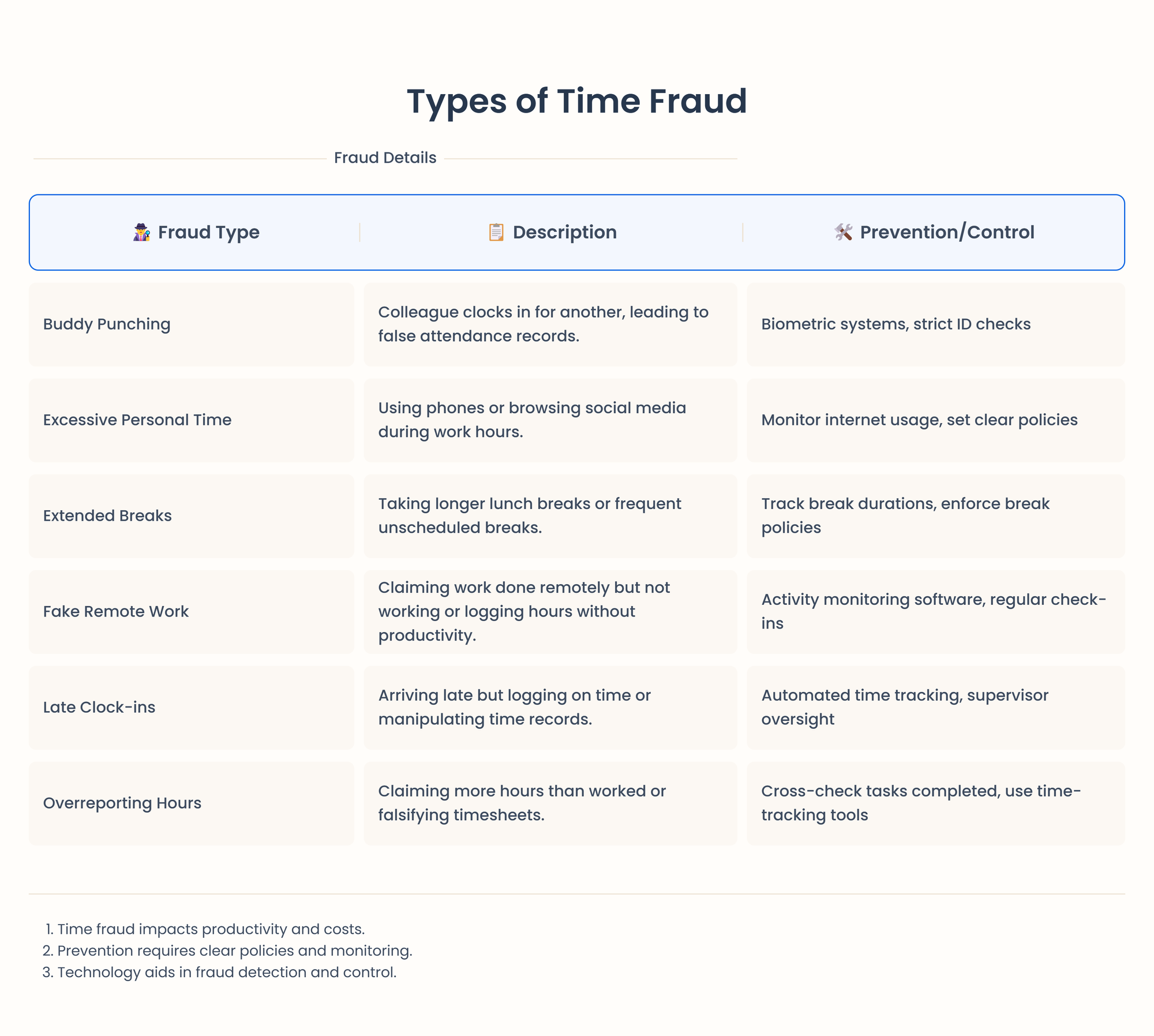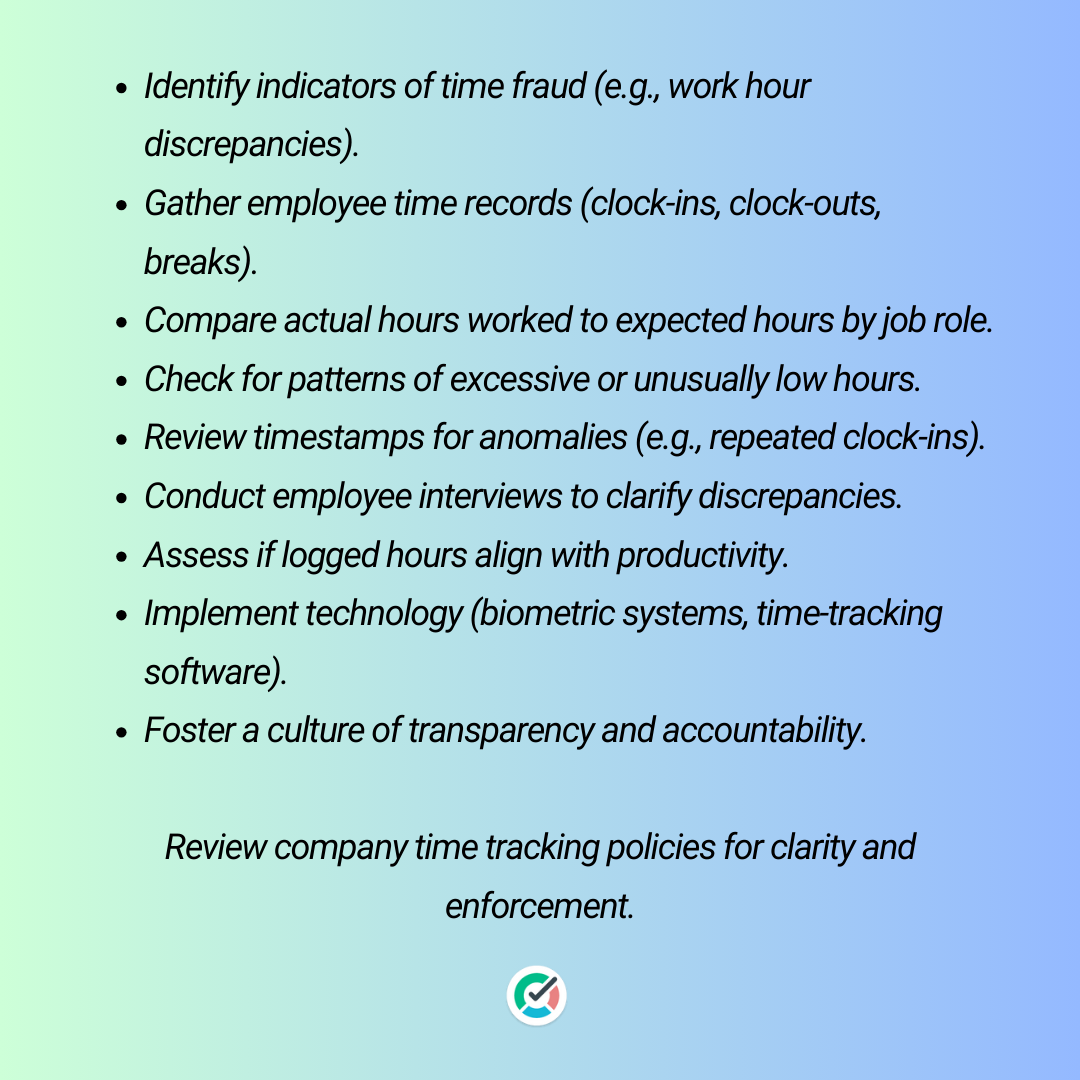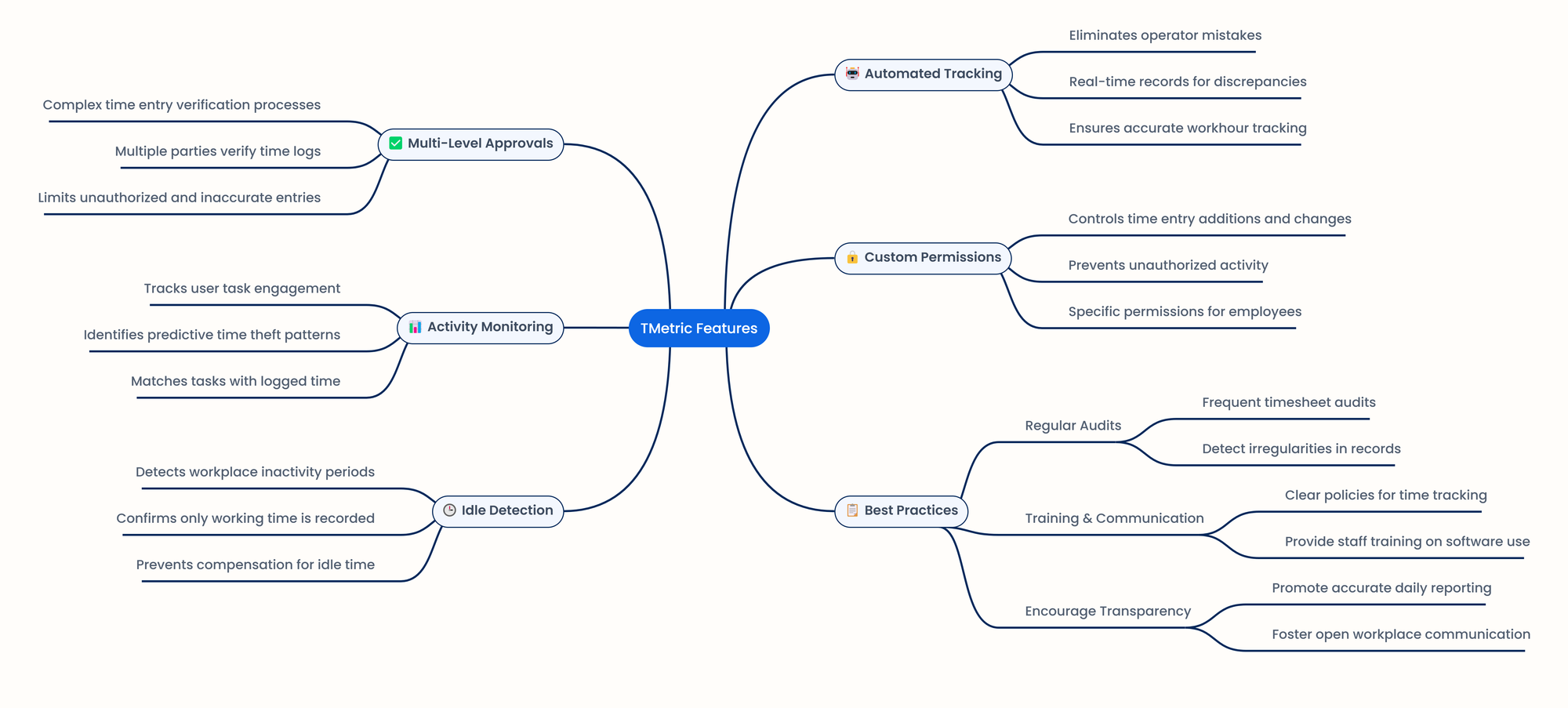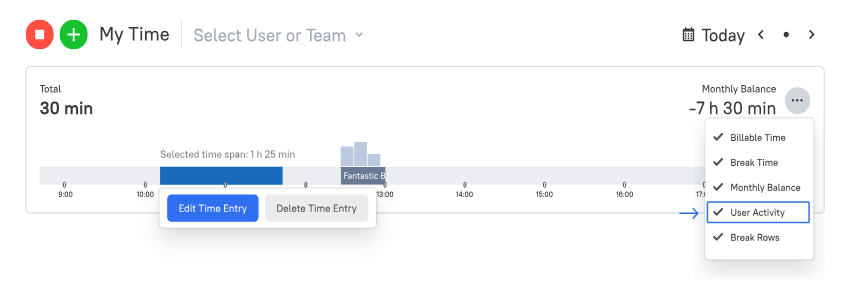Timesheet Fraud: Detection, Costs, and Prevention Strategies
Learn how to detect and prevent timesheet fraud in your organization with effective strategies and understand the costs associated with this fraudulent activity.

Workplace time theft has become a concerning issue because it challenges employee conduct, productivity metrics, transparency, and workforce accountability dynamics in the modern high-speed business environment.
What is Timesheet Fraud
Workers commit timesheet fraud by making up work hours in ways like adding extra time (padding hours) to their report or letting another staff member enter their time (buddy punching).
How Much Does Time Fraud Cost to Your Business
American businesses experience substantial financial impacts from timesheet fraud cost, which professionals frequently call "time theft."
Researchers estimate U.S. companies face timesheet fraud consequences of losing $400 billion each year, primarily because of decreased productivity and errors made during payroll operations.
Time fraud cases by employees average 4.5 hours per week through untimely reporting thus causing annual business losses of six work weeks.
Types of Time Fraud
Buddy Punching
What is it? When an employee performs entry and exit timekeeping tasks on behalf of another staff member it becomes known as this conduct.
This practice is more prevalent in industries with manual time-tracking systems, such as construction and manufacturing.
It is an illustrative example of time fraud that is hard to detect if you are not using reliable time tracking.
Revealing this deceitful practice becomes challenging because organizations without strict monitoring systems like TMetric for clocking operations enable it to escape detection.
Excessive Personal Time
While recording their work times accurately, employees can dedicate substantial periods to personal online activities including social media use and internet shopping.
Excessive personal time can also include activities like personal phone calls, texting, and gaming during work hours.
This type of time fraud is particularly common in office environments where employees have easy access to the internet and personal devices.
When employees focus on their personal activities instead of their work obligations, they create substantial work productivity losses.
Extended Breaks
When employees extend their allowed breaks or choose to take breaks without authorization, they practice this scenario of time card manipulation.
Extended breaks can also include unauthorized smoking breaks, coffee breaks, and socializing with colleagues.
This type of fraud is more likely to occur in environments where supervision is lax or where there is a lack of clear break policies.
Work interruptions and long periods away from computers result in productivity drops because employees lack oversight when not at their desks.

Fake Remote Work
Employees frequently report working from a remote location without demonstrating actual work resulting in falsification of timesheets and fraudulent productivity reports.
Fake remote work can be facilitated by the use of automated tools that simulate activity on the computer.
This type of fraud is more prevalent in roles that do not have clear, measurable outputs or deliverables.
The fraud rates are high within remote work environments since supervision becomes limited and staff can easily create misleading work logs.
Late Clock-Ins
Workers can be spotted falsifying time cards by entering the system at a delayed hour while showing as if they spent their full working shift.
Such fraudulent behavior lets employees claim payment for nonexistent work so they extract time from their employers' payroll.
This type of fraud is more common in industries with flexible work hours or where punctuality is not strictly enforced.

How to Detect Timesheet Fraud
Some methods can help detect, and in some cases, prevent timesheet fraud.
Primary Detection Methods
Biometric Systems
- Fingerprint or facial recognition for clock-in/out
- Prevents buddy punching by requiring physical presence
- Can integrate with location data to verify workplace presence and detect time clock fraud
Digital Footprint Analysis
- Monitoring computer activity and application usage patterns
- Reviewing login/logout timestamps across different systems
- Analyzing email send times and response patterns
- Checking VPN connection logs for remote workers
Pattern Recognition
- Statistical analysis of clock-in/out times for suspicious regularity
- Identifying unusual variations in work hours or overtime
- Comparing historical patterns with current behavior
- Looking for correlations between multiple employees' timing patterns
Subtle Detection Methods
Productivity Metrics
- Comparing output levels with reported hours
- Analyzing task completion rates against historical averages
- Reviewing project milestone timing
- Examining work quality variations across different time periods
Network Activity Analysis
- Monitoring gaps in network connectivity
- Analyzing browser activity patterns
- Checking for automated mouse movement tools
- Reviewing application usage consistency
Cross-Reference Verification
- Comparing badge access logs with time entries
- Checking meeting attendance records against reported hours
- Verifying collaboration tool activity timestamps
- Reviewing security camera footage timestamps
Advanced Detection Strategies
Behavioral Analytics
- Analyzing communication patterns during claimed work hours
- Monitoring response times to messages and emails
- Reviewing collaboration tool engagement levels
- Checking for inconsistencies in work patterns
System Integration Checks
- Comparing timestamps across different workplace systems
- Verifying consistency between calendar events and time entries
- Analyzing phone system usage during claimed work hours
- Reviewing building access logs against reported schedules
Peer Activity Correlation
- Analyzing team collaboration patterns
- Reviewing shared project activity timestamps
- Checking consistency of group meeting participation
- Comparing work patterns among team members.
Less Obvious Indicators
Environmental Markers
- Checking IP address locations against claimed work locations
- Monitoring device usage patterns
- Reviewing time zone consistency in digital activities
Communication Analysis
- Evaluating response delays in team communications
- Analyzing email metadata patterns
- Reviewing chat activity distributions
- Monitoring collaborative document editing patterns
Output Consistency
- Examining work quality variations across different times
- Analyzing document creation and modification timestamps
- Reviewing code commit patterns and timestamps
- Checking file access and modification logs.

What to Do When You Suspect Employee Time Theft
Document thoroughly:
- Log exact times documenting when discrepancies occur together with their repeated patterns
- Sketchy data leading to disciplinary actions should be obtained through a review of timesheets, security logs plus workplace monitoring data.
- Note your observations and relevant communications
Verify before acting:
The time records need to be compared against the access logs.
- Review surveillance footage if available
- Check project management tools and work output
- Seek professional explanations that include technical equipment issues along with misunderstandings between parties.
Take appropriate action:
- Safe discussions about employee concerns should take place during private meetings.
- Follow company policy on disciplinary procedures
- Issue written warnings if warranted
- Your organization is to deploy an effective time tracking methodology to have accurate data.
- Consult HR/legal before termination
Preventive measures:
⏳Install automated time tracking
⭐Require manager approval for overtime
✍️Establish clear time reporting policies
📋Train supervisors on monitoring procedures
Remember: Address the situation through discreet processes while logging all activities performed.
Consequences of Employee Timecard Fraud
Employee timecard fraud has serious negative consequences for organizations and their staff members.
Below we discuss how it affects businesses and employees.
Impact on the Organization
Money Loss:
Overspending: Organizations do not get their profits when employees inflate their recorded work hours because it increases expenses.
Budget Imbalances: Accurate time reporting supervision protects financial planning, prevents budget disturbances, and maintains organizational stability.
Legal and Compliance Issues:
Regulatory Violations: When employees engage in timecard fraud they break labor laws and create regulatory violations that result in statutory penalties.
Audit Risks: Unreliable time records that trigger warning signs during internal and external audits frequently require additional probes from inspectors and result in penalties.
Reputation Damage:
Public Trust: Timecard fraud that goes public causes reputation damage to the organization by reducing levels of public trust.
Client Relationships: Business relationships worsen when clients cannot rely on accurate data.
Operational Inefficiencies:
Productivity Loss: Mishandling in timekeeping masks fundamental productivity problems – it negatively affects organizations since their operational inefficiency cannot be properly detected and corrected.
Resource Misallocation: Businesses in any industry, if affected by fake timecards, develop operational problems that result in resource allocation errors and affect project scheduling and delivery deadlines.
Employee Morale:
Trust Issues: The practice of fraudulent timecard submissions produces workplace distrust which jeopardizes colleagues' connection and their company allegiance.
Unfair Practices: Employees dedicated to integrity see fraudulent acts as unfair practices that negatively affect their morale.
For the Employees
Disciplinary Actions:
Termination: Workers who commit timecard fraud face employment penalties resulting in their eventual dismissal from their jobs.
Legal Consequences: Timecard fraud offenders who face serious charges can receive legal punishment (monetary fines).
Career Impact:
Reputation: The practice of timecard fraud damages both an employee's professional standing and makes successful job acquisition beyond reach afterward.
References: If an employer provides unfavorable reports about an employee to potential jobs the worker's professional growth will be obstructed.
Financial Penalties:
Restitution: Staff members must reimburse money they receive mistakenly due to irregular timecard entries.
Legal Fees: Employees will face substantial monetary costs when legal authorities take action against them.
Psychological Impact:
Stress and Anxiety: When caught and facing punishment for fraud, employees experience high levels of both stress and anxiety.
Guilt: Job satisfaction and mental well-being are negatively impacted by guilt and remorse that constantly accompany employees' experiences.

6 Steps to Prevent Time Fraud
1. Implement Time Tracking
Time tracking systems provide key controls for preventing and detecting timesheet fraud.
Time tracking systems with automation should be used because they reduce the potential for human error in report alterations.
The systems feature three components:
- biometric scanners
- GPS tracking
- Automatic time stamping abilities
Through automated clock-in/out systems, humans no longer have to manually enter data which leads to data errors
Organizations need to establish systems that monitor data in real time while performing analytics to find unusual patterns and validate suspect transactions immediately.
These systems minimize the opportunity for manual manipulation, – real-time monitoring and analytics can easily detect anomalies.
- Through automated clock-in/out systems, humans no longer have to manually enter data which leads to data errors.
- Scanning verification solutions trace workplace participation of all personnel
- Proof of work location arises from reportable employee geolocation data
- Manager approval workflows add oversight.
How time trackers detect fraud:
- Data analysis tools detect abnormal time recording patterns
- A review process links entry data from door access activities to employee timesheet records
- Audit trails track timesheet modifications
- Monitoring systems detect when employees take too much unpaid work through statistical pattern analysis
- Project management tools allow HR to validate timekeeping results for projects.
- Reporting tools identify overtime abuse patterns
- Integration with project management tools validates work output.

Guidelines to Follow
- Staff should follow standardized timekeeping policies which must be openly shared with team members.
- The organization should let all staff understand both the required actions and the penalties that will occur when they do not follow guidelines.
- Employee training sessions must maintain regular schedules to teach accurate time reporting practices and the beliefs for time fraud.
- The organization should perform regular internal audits on timecards which check accuracy and identify feature any errors.
- Time tracking systems should include both random checkpoints and unannounced time audits as part of their functionality.
- External audits should become a part of your system to maintain both impartiality and thoroughness standards.
- Outside auditors evaluate businesses' timekeeping systems with objective sight.
2. Establish Clear Policies and Procedures
Timekeeping Policies
- Develop and communicate clear policies and procedures for timekeeping. Ensure that employees are aware of the expectations and the consequences of non-compliance.
- Provide regular training sessions to educate employees on the importance of accurate time reporting and the repercussions of time fraud.
3. Conduct Regular Audits
Internal audits
- Perform regular audits to verify the accuracy of timecards and identify any discrepancies.
- This can include spot checks and random audits.
External audits
- Consider external audits to ensure impartiality and thoroughness.
- Third-party auditors can provide an unbiased assessment of timekeeping practices.
4. Keep Open Communication
- Leadership needs to foster an environment where ethical integrity along with honesty as a core value receives rewards.
- A leadership position demands good behavioral examples from its members.
- All employees should have clear channels for reporting suspected fraud incidents while enjoying complete anonymity during the process.
- A detailed system must exist that defines acceptable behavioral responses to reported time fraud through established warning protocols and suspension and termination procedures.
- Company personnel need to understand how severe time fraud situations can have legal consequences.
- Leadership should encourage open communication and create reliable mechanisms for employees to report suspected fraud anonymously.
5. Set Up Alerts and Notifications
Anomaly Detection
- Use machine learning and data analytics to recognize patterns and detect anomalies, such as unusually long hours or frequent breaks.
Automated Alerts
- Set up automated alerts to notify managers of any suspicious activities or deviations from normal behavior.
6. Enforce Consequences for Non-Compliance
Disciplinary Actions
- Clearly outline the disciplinary actions for time fraud, including warnings, suspensions, and termination.
Legal Consequences
- Make employees aware of the potential legal consequences, including fines and imprisonment, for severe cases of time fraud.

How TMetric Can Prevent Time Theft

Features of TMetric That Prevent Timesheet Fraud

- Multi-Level Approval Processes
Through TMetric businesses can establish complex time entry verification processes that operate at different approval levels.
In particular, multiple parties can verify time logs through this system which limits both unauthorized and inaccurate entries during the process.
- Automated Time Tracking
The ability of automated time monitoring to eliminate operator mistakes produces well-kept tracking records.
Live monitoring through TMetric produces real-time records that help detect discrepancies between reported work hours and actual performed job duties.
- Activity Monitoring
With its activity monitoring features TMetric tracks how users work with their tasks.
Identifying predictive time theft patterns becomes easier when users do not have matching tasks during their logged time periods45.
- Customizable Permissions
Through the software users receive authority to specify what aspects of time tracking individual employees can perform.
Activity monitoring ensures potential fraud prevention through specific user permissions that control time entry additions and changes3.
- Idle Detection
A built-in idle detection system within TMetric detects periods of workplace inactivity to confirm that only working time is recorded.
TMetric uses detection to stop employees from receiving compensation for times of overconsumption.
Best Practices for Using TMetric
To maximize the effectiveness of TMetric in preventing timesheet fraud, organizations should consider the following best practices.
- Regular Audits: Timesheet audits must happen frequently to detect irregularities.
- Training and Communication: All policies for tracking time need clear understanding by staff members while providing training that covers the effective use of the software.
- Encourage Transparency: Promote a workplace atmosphere which enables team members to understand daily reporting accuracy stands as essential.




